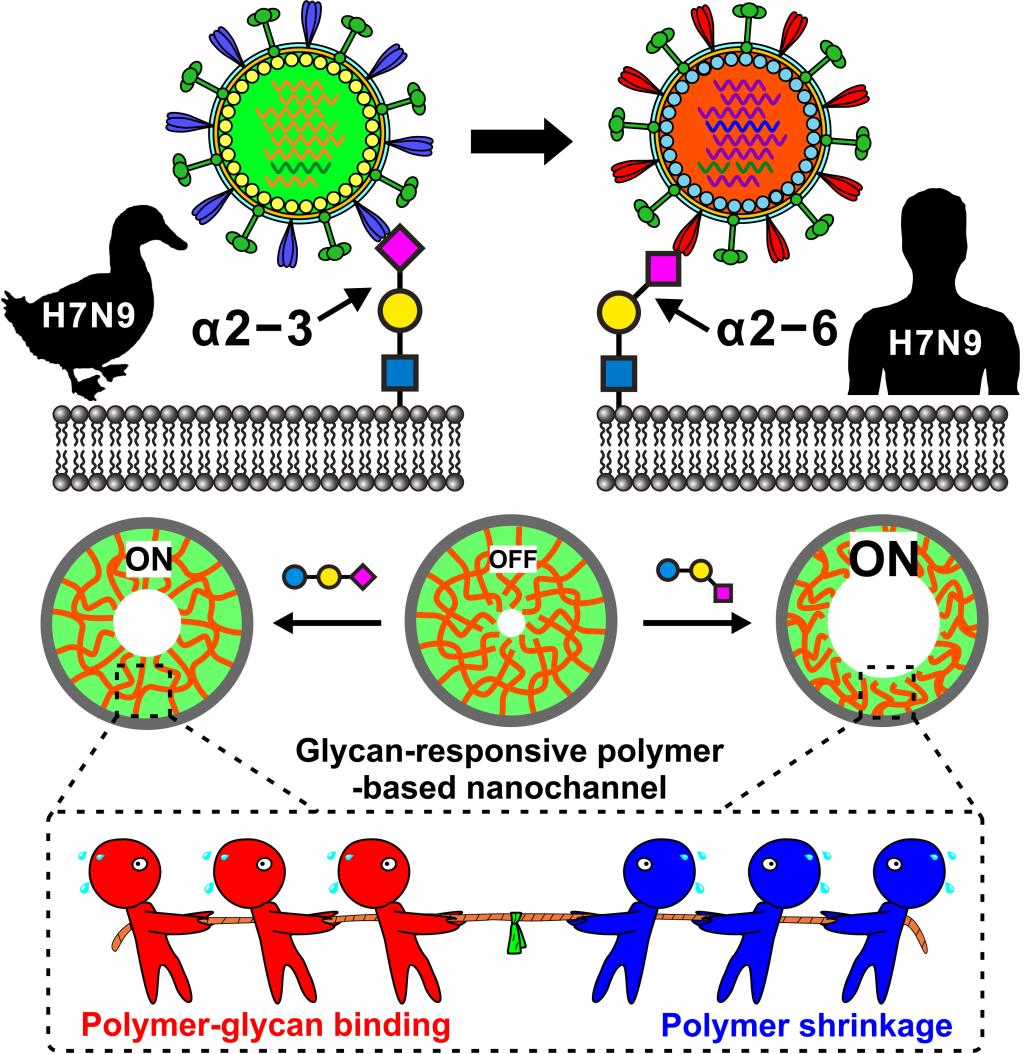Dr. Minmin Li in a research group of Bio-separation and Interfacial Molecular Mechanism, made progress in the precise discrimination of sialylated glycan (SG) through biomimetic ion nanochannels, and related results were published in the form of Edge Article in the Chemical Science (2020, DOI: 10.1039/c9sc05319k).
The SG is usually connected to the terminal end of the glycan in the form of α2-3 or α2-6, which constitutes the rich distribution of SGs on the surface of mammalian cells or some secreted proteins. This outermost position and its wide distribution make the SGs play important roles in the processes of viral infection, immune response, and cancer development. However, the composition of SG is complex, the connection forms are diverse, and even linkage isomers exist, which greatly increases the difficulties of identification and structural analysis.
Dr. Li and Dr. Yuting Xiong grafted a glycan-responsive polymer into the nanochannel, by taking advantages of the shrinkage of the polymer by different glycans, different degrees of “OFF‒ON” changes in ion current were realized in the nanochannel system. Importantly, different SG linked isomers were discriminated clearly and efficiently. This work further expands the application of biomimetic ion nanochannel devices in biomolecule recognition and sensing, especially in the identification and structural analysis of complex glycans.
At the same time, the research team also used the design concept of smart polymers to realize the construction of calcium ion self-regulated bionic ion channels (NPG Asia Materials, 2019, 11, 46) and cyclic adenosine monophosphate-regulated nano ion channels (J. Mater. Chem B. 2019, 7, 3710). These studies have received supports from the National Natural Science Foundation of China, the Startup Fund of DICP for a new group. At the same time, this work is also one of the articles dedicated to the 70th anniversary of DICP.
Biomimetic nanochannels for the discrimination of sialylated glycans via a tug-of-war between glycan binding and polymer shrinkage
Minmin Li,Yuting Xiong,Dongdong Wang,Yunhai Liu,Bing Na,Haijuan Qin,Jinxuan Liu,Xinmiao Liang* and Guangyan Qing*
Chem. Sci., 2020, 11, 748
Advance Article DOI: 10.1039/c9sc05319k

Sialylated glycans that are attached to cell surface mediate diverse cellular processes such as immune responses, pathogen binding, and cancer progression. Precise determination of sialylated glycans,particularly their linkage isomers that can trigger distinct biological events and are indicative of different cancer types, remains a challenge, due to their complicated composition and limited structural differences. Here, we present a biomimetic nanochannels system integrated with the responsive polymer polyethyleneimine-g-glucopyranoside (Glc-PEI) to solve this problem. By using a dramatic “OFF–ON”change in ion flux, the nanochannels system achieves specific recognition for N-acetylneuraminic acid (Neu5Ac, the predominant form of sialic acid) from various monosaccharides and sialic acid species.Importantly, different “OFF–ON” ratios of the conical nanochannels system allows the precise and sensitive discrimination of sialylated glycan linkage isomers, a2–3 and a2–6 linkage (the corresponding ion conductance increase ratios are 96.2% and 264%, respectively). Analyses revealed an unusual tug-of-war mechanism between polymer-glycan binding and polymer shrinkage. The low binding affinity of Glc-PEI for the a2–6-linked glycan caused considerable shrinkage of Glc-PEI layer, but the high affinity for the a2–3-linked glycan resulted in only a slight shrinkage. This competition mechanism provides a simple and versatile materials design principle for recognition or sensing systems that involve negatively charged target biomolecules. Furthermore, this work broadens the application of nanochannel systems in bioanalysis and biosensing, and opens a new route to glycan analysis that could help to uncover the mysterious and wonderful glycoworld.
Footnotes
Dedicated to the 70th anniversary of Dalian Institute of Chemical Physics, CAS.